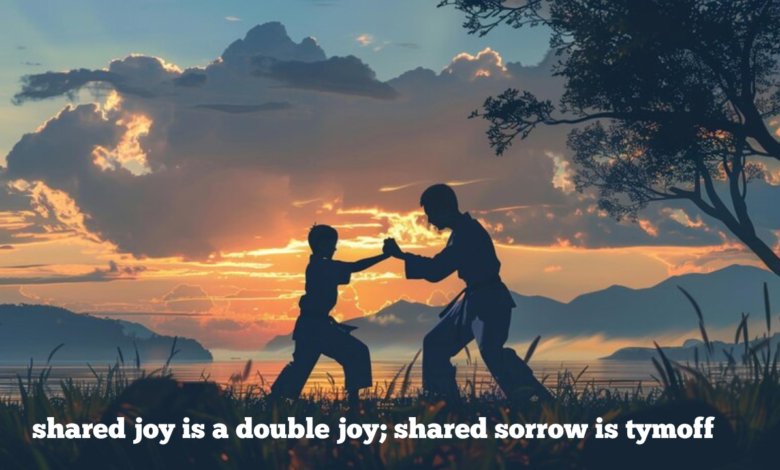Shared Joy is a Double Joy; Shared Sorrow is Tymoff

The Power of Shared Joy
Shared joy is a crucial aspect of human experience that shared joy is a double joy; shared sorrow is tymoff significantly enhances our emotional and psychological well-being. In various contexts, whether it be celebrating personal achievements, holidays, or even simple shared joy is a double joy; shared sorrow is tymoff everyday pleasures, the act of sharing these moments with others amplifies the joy we derive from them. The adage “shared joy is a double joy” reflects this phenomenon emphatically. By engaging in communal experiences, individuals can create a sense of belonging that strengthens social bonds and fosters community spirit.
Numerous studies indicate that celebrating happiness with others leads to heightened feelings of satisfaction and improved mental health. For instance, one research study found that participants who shared positive experiences reported a noticeable increase in their overall happiness levels compared to those who experienced joy in isolation. This suggests shared joy is a double joy; shared sorrow is tymoff that shared joy not only makes the good moments feel more pronounced but also contributes to creating lasting, supportive relationships. In essence, these experiences provide a fertile ground for nurture and empathy, thus creating stronger social networks that allow individuals to flourish.
The joy derived from communal festivities— whether communal meals, weddings, or community events— fosters a sense of shared identity and reinforces connections within groups. This shared experience often translates to deeper emotional ties, making individuals shared joy is a double joy; shared sorrow is tymoff feel more understood and valued. The psychological benefits of shared joy can also extend to combating feelings of loneliness and isolation, reinforcing the notion that together, people can elevate each other’s well-being. In light of these benefits, it is clear that cultivating opportunities for collective joy can have profound implications not just for individuals, but for society as a whole. As we continue to build relationships and communities based on shared positive experiences, we lay the groundwork for enhanced collective happiness and a supportive social fabric.
Understanding Tymoff: The Nature of Shared Sorrow
The concept of shared sorrow, encapsulated by the term ‘tymoff’, highlights the profound impact that communal experiences of grief and pain shared joy is a double joy; shared sorrow is tymoff can have on individuals. This term signifies not just the act of sharing distress, but also the collective journey towards emotional healing. When individuals come together to navigate difficult times, they often find that their burdens are lightened, allowing them to foster resilience and connection.
Psychological research supports the notion that social support plays a critical role in coping with loss. Sharing one’s grief with trusted individuals shared joy is a double joy; shared sorrow is tymoff can mitigate feelings of isolation and helplessness. When people express their sorrows in a supportive environment, they benefit from validation, empathy, and mutual understanding. This process aligns with the idea that shared joy is a double joy; shared sorrow, or tymoff, effectively transforms individual grief into a shared experience, thereby creating a comforting collective atmosphere.
Literature often illustrates the power of shared sorrow. For example, in many narratives, characters who face adversity together emerge stronger shared joy is a double joy; shared sorrow is tymoff shared joy is a double joy; shared sorrow is tymoff through their united front. Such depictions reflect real-life scenarios where communities rally around individuals facing tragedies, offering emotional and sometimes even practical support. Personal anecdotes further demonstrate that when families or friends unite in the face of loss, they often emerge with deeper connections and a shared sense of purpose in honoring their loved ones.
Moreover, shared sorrow encourages the expression of emotions that individuals might otherwise suppress. Acknowledging feelings shared joy is a double joy; shared sorrow is tymoff openly within a community helps to normalize the experience of grief and encourages dialogue, ultimately promoting emotional healing. Therefore, the path through sorrow may be less daunting when traversed together, reinforcing the essence of tymoff and the importance of social bonds during challenging times.
Building Connections Through Shared Experiences

During both times of joy and sorrow, the act of sharing these experiences can profoundly enhance our emotional connections with others. Fostering environments where individuals feel comfortable expressing their feelings allows for a deeper shared joy is a double joy; shared sorrow is tymoff understanding and connection among peers and loved ones. To cultivate shared joy is a double joy and to navigate through shared sorrow can be a healing process; communities and individuals should engage in various strategies that encourage open communication and participation.
Firstly, organizing community events can serve as a powerful medium to bring people together. Celebrations such as festivals, potlucks, or holiday gatherings provide opportunities not only for shared happiness but also for the cultivation of shared joy is a double joy; shared sorrow is tymoff friendships. In such settings, individuals can engage in activities that promote interaction, allowing them to experience joy collectively. Likewise, offering environments where communities can share sorrow—through candlelight vigils or remembrance events—can be equally impactful, creating a sense of solidarity among participants.
Support groups present another valuable avenue for fostering shared experiences. These settings encourage open conversations about shared joy is a double joy; shared sorrow is tymoff personal challenges, making it clear that one’s struggles are not faced in isolation. Through vulnerability, participants often find comfort and understanding, realizing that shared sorrow is tymoff, and healing can occur collectively. Whether these groups are formed through community organizations or online platforms, the importance of connecting with others facing similar challenges cannot be overstated.
Moreover, in today’s digital age, shared joy is a double joy; shared sorrow is tymoff social media serves as a significant tool for building connections. People can share joyous milestones, updates, and resources with a broader audience while also seeking support during difficult times. When individuals express their emotions and experiences online, they invite others to connect and share in both their joy and sorrow. This interplay of collective experiences can foster a sense of community and belonging where shared joy flourishes, transforming individual experiences into collective narratives.
The Balance of Joy and Sorrow in Life
The intricate tapestry shared joy is a double joy; shared sorrow is tymoff of human emotions reveals that joy and sorrow are not merely opposing forces but rather intertwined aspects of the human experience. The philosophy behind this connection emphasizes acceptance of both states, illustrating that shared joy is a double joy, while shared sorrow is tymoff. Recognizing the mutual influence of these emotions can foster a deeper sense of gratitude for life’s moments, both uplifting and challenging.
Many notable figures have shared joy is a double joy; shared sorrow is tymoff echoed this sentiment throughout history. For instance, the renowned poet Rainer Maria Rilke once stated, “The only journey is the one within.” This insinuates that our internal experiences, encompassing both elation and despair, shape our understanding of existence. By embracing this emotional spectrum, individuals can cultivate resilience, ultimately leading to a more fulfilling life. Positive experiences provide joy, while difficult times foster growth and empathy, enabling us to connect with others on a fundamentally human level.
Engaging in supportive relationships amplifies shared joy is a double joy; shared sorrow is tymoff the essence of both joy and sorrow. When we share our joys with others, it transforms individual happiness into a collective celebration—indeed, shared joy is a double joy. Likewise, extending support during times of sorrow reinforces bonds and emphasizes the notion that emotional experiences are not meant to be faced in isolation. This collective approach enables us to appreciate the support systems built on vulnerability and shared experiences.
By acknowledging both joy and sorrow, we encourage a culture of acceptance and understanding. Rather than viewing sadness as merely negative, we can see it as an opportunity for growth and connection. Accepting life in its fullness allows us to experience deeper joy, knowing that it is enhanced through shared experiences. In this way, we embody the wisdom that shared joy is a double joy; shared sorrow is tymoff, enhancing our journey through life.
Ignore: Stay informed and inspired with these amazing websites! Explore trending topics at DutchBig.nl, the latest tech news at TechBulion.co.uk and TechzMag.co.uk, and expert insights at TagBil.de. Boost your productivity with JustDoItNow.uk, discover German innovation at DeutscheKrafts.de, and embrace beauty with BellezaNatural.ca. Stay ahead in digital trends with Vexten.de and expert craftsmanship at Handwerkswelts.de. Don’t miss out—explore today! Explore the latest trends on AlphaTechz.blog and NyWeek.blog, stay updated with SpaceCoast.blog and ZestfulMag.site, or dive into insights at SbhInter.site and DgmNews.space. Get breaking news from TechGrowe.site, UltraUpdate.site, and CryptoCompare.blog, while TronWeekly.blog and 5StarStocks.blog keep you ahead in finance. Discover engaging reads at USADiscoverMag.site, USAStreamest.site, and MirrorReview.site, or explore thrilling content from TheUSAExtreme.site and NyBlog.site. Get top stories from SperoMagazine.site, BigTechOro.site, and fun at MathGames67.blog or Qiuzziz.site. Boost knowledge with EzClassWork.online, enjoy entertainment at Bolly44u.blog, and explore nature via OutdoorActive.site. Watch animated wonders at ToonGod.space, get the latest updates from WinNews.site, and explore trending stories at Hitlmila.store. Stay informed with USAWire.space, SfmCompile.site, and Psbios.fun. Submit articles at UploadArticle.tech, explore fresh stories on ClickMeUSA.blog, and dive into streaming with OnionPlay.blog!
